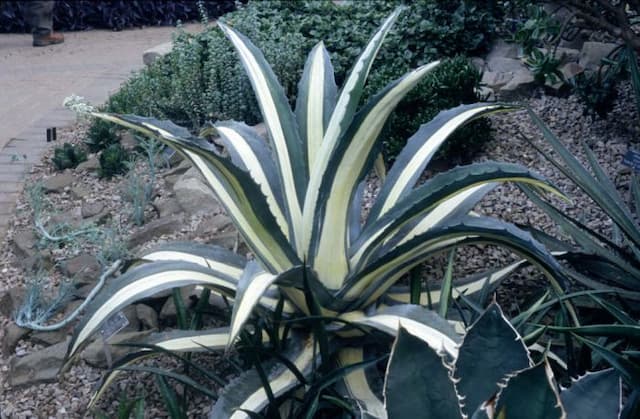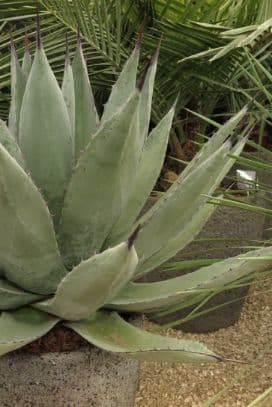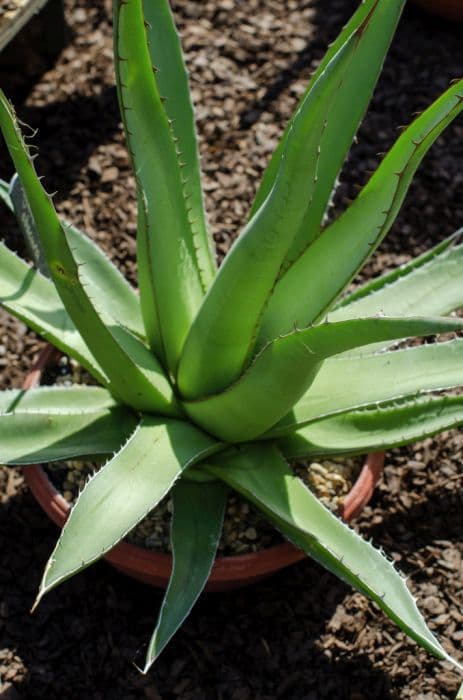Great camas Camassia leichtlinii subsp. leichtlinii

ABOUT
Commonly known as the Great Camas, this plant is a perennial that flourishes in grassy and open woodland environments. It sports a basal rosette of linear leaves that stretch out gracefully, often with a slightly ribbed texture. When the plant blooms, it produces an upright, multi-flowered spike adorned with star-shaped flowers. These blossoms can vary in color, typically showcasing shades ranging from deep blue to lavender, and occasionally white. The flowers are symmetrically arranged in a raceme, radiating an attractive appeal that can be a focal point in gardens. Each flower features six petals, and in the center, there are contrasting yellow anthers that add a pop of color and interest. The bulbs of the plant, which grow underground, have a historical significance as a food source for indigenous peoples and are edible when cooked. Overall, the Great Camas is known for its striking floral display and the lush green foliage that supports it, creating a picturesque scene during its blooming season.
About this plant
 Names
NamesFamily
Asparagaceae
Synonyms
Large Camas, Great Camas, Leichtlin's Camas, Quamash, Wild Hyacinth
Common names
Camassia leichtlinii subsp. suksdorfii, Camassia suksdorfii.
 Toxicity
ToxicityTo humans
The plant commonly known as large camas is not considered highly toxic to humans. However, the bulbs contain glycosides that can be problematic if consumed in large quantities or if not prepared properly. Indigenous peoples have traditionally eaten the bulbs, but they require thorough cooking to break down these compounds. If someone eats the raw bulbs or undercooked large camas, they may experience symptoms like nausea, vomiting, and diarrhea.
To pets
Large camas contains compounds that can be toxic to pets if ingested. Similar to humans, the primary concern would be the glycosides in the bulbs. If a pet consumes a significant amount of the bulbs, especially if they are raw or undercooked, they may exhibit symptoms such as gastrointestinal upset, including vomiting and diarrhea. In severe cases, ingestion could lead to more serious symptoms such as weakness and changes in heart rate, although such extreme reactions are less common. It is generally advisable to prevent pets from ingesting large quantities of this plant.
 Characteristics
CharacteristicsLife cycle
Perennials
Foliage type
Deciduous
Color of leaves
Green
Flower color
Blue
Height
2-3 feet (60-90 cm)
Spread
1-2 feet (30-60 cm)
Plant type
Bulb
Hardiness zones
5
Native area
North America
Benefits
 General Benefits
General Benefits- Aesthetic Appeal: Great Camas is known for its attractive blue-violet flowers, which add color and interest to gardens and natural landscapes.
- Wildlife Attraction: The flowers provide nectar for a variety of pollinators, including bees and butterflies, which can promote biodiversity.
- Low Maintenance: Once established, Great Camas is relatively low maintenance, requiring minimal care beyond occasional watering during extended dry periods.
- Naturalizing: This species tends to naturalize well, meaning it can spread and create natural-looking drifts in suitable environments.
- Drought Tolerance: Great Camas is drought-tolerant once established, making it suitable for xeriscaping and low-water gardens.
- Erosion Control: The plant's robust root system can help stabilize the soil and control erosion on slopes or banks.
- Edible Bulbs: The bulbs of Great Camas have traditionally been used as a food source by indigenous peoples of North America, although they must be properly prepared to be edible.
- Seasonal Interest: This perennial plant provides seasonal interest in the spring and early summer when it blooms.
- Heritage and Cultural Significance: Great Camas has a rich ethnobotanical history, being valued and used by indigenous cultures for thousands of years.
 Medical Properties
Medical Properties- This plant is not used for medical purposes.
 Air-purifying Qualities
Air-purifying QualitiesThis plant is not specifically known for air purifying qualities.
 Other Uses
Other Uses- Large Camas bulbs can serve as a heat source in a survival situation; when heated, they can retain warmth for a considerable time.
- The fibers of the Camas plant can be used for weaving small items such as mats or decorations, showcasing indigenous crafting methods.
- Dried Camas stems provide material for making tinder or kindling in traditional fire-making practices.
- Native tribes sometimes used Camas as a trading commodity due to its value as a food source and its storability.
- The sap from Camas can be applied to fishing lines to strengthen them without synthetic materials.
- In a natural dye process, Camas flowers can contribute blue or purple hues to textiles depending on the mordant used.
- Camas seed pods, when dried, can be used in rattles or as a noise-making component in traditional dance regalia.
- The plant's sturdy leaves have historically been used to fashion impromptu containers or wrappers for food during cooking.
- Dried Camas can be used to stuff small pillows or sachets, providing a cushioning material that is biodegradable and sustainable.
- When in full bloom, Camas plants are effective in garden landscaping for attracting pollinators such as bees and butterflies.
Interesting Facts
 Feng Shui
Feng ShuiThe Camass is not used in Feng Shui practice.
 Zodiac Sign Compitability
Zodiac Sign CompitabilityThe Camass is not used in astrology practice.
 Plant Symbolism
Plant Symbolism- Resilience: Camass (Camassia leichtlinii subsp. leichtlinii) bulbs can survive intense forest fires and return in abundance, symbolizing the ability to endure challenges and recover.
- Persistence: Camass has a long growing season and can persist through varying conditions, symbolizing steadfastness and determination.
- Nutrition and sustenance: Having been used as a food source by Indigenous peoples of North America, camass symbolizes nourishment, both physical and spiritual.
- Adaptability: As a plant that adapts well to both wet and dry prairies, camass symbolizes the ability to thrive in different environments and situations.
- Connection to nature: Camass's historical significance to indigenous cultures as a food source symbolizes a deep connection to the land and natural world.
 Water
WaterCamassia, commonly known as wild hyacinth, should be watered deeply to encourage root development; generally, one inch of water per week, either from rainfall or supplemental watering, is sufficient. During its active growth in the spring, maintain consistent moisture, but do not overwater, as Camassia is tolerant of moist conditions but not waterlogged soil. Once established, Camassia can tolerate some dry periods. In absence of rain, watering every seven to ten days with approximately half a gallon per square foot of soil should be adequate.
 Light
LightWild hyacinth thrives in full sun to partial shade locations. The ideal spot would offer them morning sunlight with some afternoon shade, especially in regions with hot summers. They are adaptable but flower best with at least six hours of direct sunlight daily.
 Temperature
TemperatureWild hyacinth can withstand a range of temperatures and is hardy in USDA zones 4 to 8. It can survive winter lows down to -30°F and summer highs up to 90°F, but it prefers the moderate temperatures of spring and fall. Ideal growing conditions are between 60°F and 75°F.
 Pruning
PruningWild hyacinth does not require extensive pruning, but removing spent flower stalks after blooming can encourage the plant's energy to be redirected into storage for the next season. It's best to prune in late spring or early summer, after the plant has finished flowering. No other regular pruning is needed for this plant.
 Cleaning
CleaningAs needed
 Soil
SoilGreat Camas thrives best in a well-drained soil mix that is rich in organic matter. A suitable blend would consist of loamy garden soil, compost, and leaf mold or finely shredded bark to enhance drainage. The soil pH should be slightly acidic to neutral, ideally between 6.0 and 7.0.
 Repotting
RepottingLarge Camas bulbs should be repotted every 2-3 years to prevent overcrowding and to refresh the soil. The best time to repot is after the foliage has died back following their flowering period in late spring or early summer.
 Humidity & Misting
Humidity & MistingLarge Camas does not have specific humidity requirements and can adapt to a wide range of humidity levels found in typical garden environments. As long as the soil moisture is well-regulated, ambient outdoor humidity levels should suffice.
 Suitable locations
Suitable locationsIndoor
Place Large Camas in bright light with well-draining soil.
Outdoor
Plant in sun or part-shade in fertile, well-draining soil.
Hardiness zone
4-8 USDA
 Life cycle
Life cycleCamassia leichtlinii subsp. leichtlinii, commonly known as Great Camas, begins its life cycle with seed germination, which typically occurs in autumn or early winter, with seedlings developing a small bulb. After winter dormancy, the bulb sends up a basal rosette of leaves in early spring, and as temperatures increase, a flowering stalk arises, blooming from late spring to early summer with star-shaped blue flowers. Post blooming, the flowers get pollinated by bees and other insects, leading to the development of capsules containing numerous small seeds which ripen by late summer. The plant then goes into a dormant phase during the dry summer season, and the foliage dies back as the bulb remains dormant underground. When autumn arrives, the cycle begins anew with germination of seeds or growth from bulbs that may multiply vegetatively, gradually forming clumps of new plants over successive seasons. Mature Great Camas plants may take several years to flower as they require sufficient energy stores in the bulb to produce their tall flowering stalks.
 Propogation
PropogationPropogation time
Spring to summer
Propogation: The best time for propagating Camassia leichtlinii, commonly known as Great Camas, is in autumn after the foliage has died back. The most popular method for its propagation is by dividing the bulbs. During the cooler fall months, gardeners dig up the clumps of bulbs and gently separate them, ensuring that each division has at least one growth point or bud. These individual bulbs are then planted immediately in well-draining soil at a depth of about 3 to 4 inches (about 7.5 to 10 centimeters), spaced approximately 8 to 12 inches apart (20 to 30 centimeters). The newly planted bulbs will establish roots before winter and will result in flowering plants in the spring. Care should be taken to plant them in a spot that receives full sun to light shade, and in an area that stays relatively dry during their summer dormancy.









